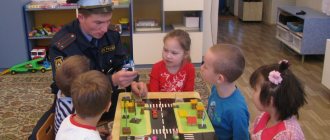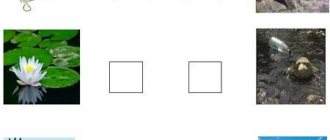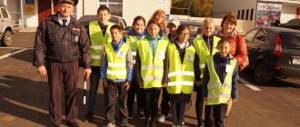Class 4 traffic rules lesson “Road Rules”. methodological development (grade 4) on the topic
Teacher Sukhovey Zh.V.
Lesson on traffic rules in 4th grade
"Traffic Laws".
Goal: To form schoolchildren’s ideas about road safety when moving along streets and roads.
Tasks:
- Introduce the history of road rules; deepen students' knowledge of traffic rules; teach to recognize road signs.
- Develop children's creative abilities; develop the ability to independently use the acquired knowledge in everyday life.
- To develop skills in following the basic rules of behavior for students on the street and road, in order to prevent children from road traffic injuries.
Progress of the event.
– Today our class hour will be devoted to traffic rules.
– Why do you need to know the rules of the road? (It is necessary to study and know traffic rules in order not to endanger your life and the lives of other people).
– Listen a little about the history of traffic rules.
- The history of road construction and information about the peculiarities of traffic on them goes back to the distant past. In Russia, the first paved roads were made of round logs laid in rows. Can you imagine how it shook on this road? It was decided to pave the main Moscow streets with stone in 1692. According to the royal decree, no one was allowed into the city until three stones, no smaller than a goose egg, were handed over to the guards.
- The first road appeared in Russia in 1722. By order of Peter I, it was laid between Moscow and St. Petersburg. The road was covered with gravel.
– What are the roads covered with now? (Now roads are covered with a layer of special petroleum resin, bitumen or asphalt).
- Previously, there were no sidewalks on the streets. Every year more and more carriages appeared on the street, and the number of accidents grew. In 1782, a new theater building was built in Paris. A large number of carriages and pedestrians moved along the streets. The carriages collided and crushed people. And people ended up in the hospital instead of the theater. Then the city authorities divided the road between carriages and pedestrians. People began to walk along the sidewalk.
- Now there are sidewalks in all cities, towns and villages. This part of the street belongs entirely to the people. On busy streets, sidewalks are separated from the roadway by brightly colored barriers.
– How should you move along the sidewalk? (Move on the right side).
- Sidewalks are installed higher than the roadway. Why do they do this? (So that when it rains, water drains faster from them, so that cars don’t accidentally drive onto the sidewalk and hit passers-by, in order to protect pedestrians and protect them from traffic).
- Nowadays it is difficult to imagine that you can do without a sidewalk. There is a certain order in the apparent chaos of traffic. All transport is subject to a strict law called “Road Rules”.
- The rules themselves were born a long time ago... Attempts to introduce rules for driving on streets and roads were created at a time when horse-drawn carriages drove along the streets. These rules were, of course, not the same as they are now - much simpler. But even then everyone had to know them. The first rules were created for cab drivers and coachmen. Then bicycles appeared (two-wheeled, three-wheeled). The first car, a steam car, was created in 1769 by the Frenchman Jean Cugnot. In 1885, German inventors Karl Benz and Daimler created a car with a gasoline engine - a motorized stroller. Later, cars with internal combustion engines appeared.
- With the advent of cars, new rules appeared. In England, for example, when the first cars appeared, a special decree was issued that said: “In cities, a person with a red flag should run in front of a mechanical carriage, thereby warning of danger.” When the first cars appeared in St. Petersburg and Moscow, the city duma ordered their owners to drive around the city no faster than 12 km/h.
- The need for traffic regulation arose in those days when there were no cars yet, and the streets were dominated by horse-drawn carriages.
- There are a lot of road signs. There are prohibitive, prescriptive, warning, and informational signs. That's not all. Priority signs, service signs, additional information signs. In order not to confuse them and to navigate faster, each group is assigned its own color - red, blue and a special shape - round, triangular, square, rectangular.
Quiz.
— Now we’ll see how well you know the rules of the road.
The number of road traffic accidents occurring both in cities and in rural areas is growing every year. In many such incidents, the culprits are children who have little or no knowledge of traffic rules. Today we will see how much you know the rules of the road and whether you can apply this knowledge to specific situations on the road.
- Competition "Did you know?"
- Answer the questions.
- What is a sidewalk? (Road for pedestrian traffic.)
- What is a zebra? (Road markings indicating a pedestrian crossing).
- Who is called a pedestrian? (A person outside of transport, located on the road, but not working on it.)
- How to get around the tram? (Front.)
- How to get around buses and trolleybuses? (Behind.)
- Where should pedestrians walk? (On the sidewalks, keeping to the right.)
- Where can children play outside? (In places specially designated for games.)
- Which edge of the road should pedestrians walk on in places where there is no sidewalk? (On the left, towards moving traffic.)
- Can children sit in the front seat of a car? (You can, if you reach 12 years of age.)
- Is a moped driver allowed to use footpaths? (Not allowed).
- Can a cyclist ride on a road if there is a bike path nearby? (No).
- Do passengers always need to wear seat belts? (Yes, always).
- Competition "Guess the signs".
— What is the name and what does this road sign mean? (Road signs are shown)
- cycling is prohibited;
- Men at work;
- telephone;
- footpath;
- Movement Prohibition;
- Dangerous bend;
- overtaking is prohibited;
- children.
- Puzzles.
| This horse does not eat oats, instead of legs there are two wheels. Sit on horseback and race on it, but steer better. (Bike.) | Amazing carriage! Judge for yourself: The rails are in the air, and he holds them with his hands. (Trolleybus) |
| Along the side of the road Like soldiers standing, You and I all do what they tell us. (Signs) | To help you, The path is dangerous, Lights both day and night - Green, yellow, red. (Traffic light) |
| Striped horses lay across the roads. All the cars stopped, If we pass here. (Zebra crossing) | A house is walking down the street, taking us to work, not on thin chicken legs, but in rubber boots. (Bus) |
| Not alive, but walking, motionless, but leading. (Road) |
- Problems.
- Try to solve funny problems.
- Imagine that you are a trolleybus driver. At the first stop, 5 people entered the empty cabin. At the second stop, two got on and one got off, at the third, 4 passengers got on and two got off. How old is the trolleybus driver? (As old as the person to whom this question is addressed)
- The boy was riding a bicycle into the city. A car was driving towards him, with 5 women sitting in it. Each of them carried one chicken and a pair of felt boots. How many living beings were traveling to the city? (1 – boy)
Summing up the quiz.
Summary of the lesson.
- What new did you learn?
—What will we always remember?
Class hour "Road Rules" for 4th grade
Class hour - quiz on the topic “Road Rules”
Target.
To form schoolchildren’s ideas about road safety when moving along streets and roads.
Tasks.
- Introduce the history of road rules; deepen students' knowledge of traffic rules; teach to distinguish road signs;
- Develop children's creative abilities; develop the ability to independently use the acquired knowledge in everyday life.
- To develop skills in following the basic rules of behavior for students on the street and road, in order to prevent children from road traffic injuries.
Progress of the event
- Hello guys! Today our class hour will be devoted to traffic rules.
– Why do you need to know the rules of the road?
It is necessary to study and know traffic rules in order not to put your life and the lives of other people in danger.
– Listen a little about the history of traffic rules.
- The history of road construction and information about the peculiarities of traffic on them goes back to the distant past. In Russia, the first paved roads were made of round logs laid in rows. Can you imagine how it shook on this road? It was decided to pave the main Moscow streets with stone in 1692. According to the royal decree, no one was allowed into the city until three stones, no smaller than a goose egg, were handed over to the guards.
- The first road appeared in Russia in 1722. By order of Peter I, it was laid between Moscow and St. Petersburg. The road was covered with gravel.
– What are the roads covered with now? (Now roads are covered with a layer of special petroleum resin, bitumen or asphalt).
- Previously, there were no sidewalks on the streets. Every year more and more carriages appeared on the street, and the number of accidents grew. In 1782, a new theater building was built in Paris. A large number of carriages and pedestrians moved along the streets. The carriages collided and crushed people. And people ended up in the hospital instead of the theater. Then the city authorities divided the road between carriages and pedestrians. People began to walk along the sidewalk.
- – Now there are sidewalks in all cities, towns and villages. This part of the street belongs entirely to the people. On busy streets, sidewalks are separated from the roadway by brightly colored barriers.
– How should you move along the sidewalk? (Move on the right side).
- – Sidewalks are installed higher than the roadway. Why do they do this? (So that when it rains, water drains faster from them, so that cars don’t accidentally drive onto the sidewalk and hit passers-by, in order to protect pedestrians and protect them from traffic).
- – Nowadays it’s hard to imagine that you can do without a sidewalk. There is a certain order in the apparent chaos of traffic .
All transport is subject to a strict law called “Road Rules”
.
- The rules themselves were born a long time ago... Attempts to introduce rules for driving on streets and roads were created at a time when horse-drawn carriages drove along the streets. These rules were, of course, not the same as they are now - much simpler. But even then everyone had to know them. The first rules were created for cab drivers and coachmen. Then bicycles appeared (two-wheeled, three-wheeled). The first car, a steam car, was created in 1769 by the Frenchman Jean Cugnot. In 1885, German inventors Karl Benz and Daimler created a car with a gasoline engine - a motorized stroller. Later, cars with internal combustion engines appeared.
- With the advent of cars, new rules appeared. In England, for example, when the first cars appeared, a special decree was issued that said: “In cities, a person with a red flag should run in front of a mechanical carriage, thereby warning of danger.” When the first cars appeared in St. Petersburg and Moscow, the city duma ordered their owners to drive around the city no faster than 12 km/h.
- The need for traffic regulation arose in those days when there were no cars yet, and the streets were dominated by horse-drawn carriages.
- There are a lot of road signs. There are prohibitive, prescriptive, warning, and informational signs. That's not all. Priority signs, service signs, additional information signs. In order not to confuse them and to navigate faster, each group is assigned its own color - red, blue and a special shape - round, triangular, square, rectangular.
Quiz
Now we'll see how well you know the rules of the road.
The class is divided into 2 teams.
The number of road traffic accidents occurring both in cities and in rural areas is growing every year. In many such incidents, the culprits are children who have little or no knowledge of traffic rules. Today we will see how much you know the rules of the road and whether you can apply this knowledge to specific situations on the road.
- Competition “Did you know?”
Questions:
1. What is a sidewalk? (Road for pedestrian traffic.)
2. What is a zebra? (Road markings indicating a pedestrian crossing).
3. Who is called a pedestrian? (A person outside of transport, located on the road, but not working on it.)
4. How to get around the tram correctly? (Front.)
5. How to get around buses and trolleybuses? (Behind.)
6. Where should pedestrians walk? (On the sidewalks, keeping to the right.)
7. Where can children play outside? (In places specially designated for games.)
8.Which edge of the road should pedestrians walk in places where there is no sidewalk? (On the left, towards moving traffic.)
9.Can children sit in the front seat of a car? (You can, if you reach 12 years of age.)
10. Is a moped driver allowed to drive on footpaths? (not allowed).
11. Is it possible for a cyclist to ride on the road if there is a bike path nearby? (No).
12. Do passengers always need to wear seat belts? (yes, always).
2. Competition “Guess the signs”
What is the name and what does this road sign mean? Road signs are shown:
- cycling is prohibited;
- Men at work;
- telephone;
- footpath;
- Movement Prohibition;
- Dangerous bend;
- overtaking is prohibited;
- children.
- 3. Riddles
This horse does not eat oats, instead of legs there are two wheels. Sit on horseback and race on it, but steer better. (Bike.)
Amazing carriage! Judge for yourself: The rails are in the air, and he holds them with his hands. (trolleybus)
Along the side of the road Like soldiers standing, You and I all do what they tell us (Signs)
Not alive, but walking. Motionless, but leading. (Road)
To help you, the path is dangerous, both day and night are lit - Green, yellow, red (Traffic light)
Striped horses lay across the roads - All the cars stopped If we pass here. (zebra crossing)
A house is walking down the street, taking us to work, not on thin chicken legs, but in rubber boots. (Bus)
4. Problems
1. Imagine that you are a trolleybus driver. At the first stop, 5 people entered the empty cabin. At the second stop, two got on and one got off, at the third, 4 passengers got on and two got off. How old is the trolleybus driver? (as old as the person to whom this question is addressed)
2. The boy was riding a bicycle into the city. A car was driving towards him, with 5 women sitting in it. Each of them carried one chicken and a pair of felt boots. How many living beings were traveling to the city? (1 – boy) Summing up the results of competitions.
Summary of the lesson. What new did you learn? What have you learned?
Game program on traffic rules “I’m walking down the street” for 4th graders
Objectives of the event: to strengthen the children’s knowledge of traffic rules; deepen students' knowledge of traffic rules; to form the ideas of younger schoolchildren about traffic safety when moving along streets and roads; to develop skills in following the basic rules of behavior of students on the street and road, in order to prevent children's road traffic injuries.
Equipment: road signs, traffic lights, pictures.
Participants of the game: three teams (4 classes).
Game plan:
- Warm-up
- Quiz “Green sign”
- Game “Three traffic lights”
- Game “Allowed - prohibited”
- Competition – captains “Drivers Relay”
- Game “Draw the signs”
- Game with the audience “Crossroads of Mysteries”
- Game “Collect signs”
- Game “Funny traffic light”
- Game “Cyclist”
- Summarizing
- Awards
Progress of the event:
The song sounds to the tune of “A week until the second”
Pedestrians and drivers cannot live without a traffic light; it keeps order and sometimes makes adults and children a little angry: the path is closed when the light is red. Who's flying at full speed? The traffic light is dissatisfied.
Chorus: About the three colors of traffic lights Everyone remembers without talking. And the big-eyed traffic light has served us faithfully for a long time.
The yellow light is on alarmingly – This means: be careful! This means: wait, look at the road. The green light will turn on - So you need to hurry, You can go and go. Have a nice journey everyone!
Host: Guys, today we are gathered here to remember the rules of the road. The law of streets and roads is strict. He does not forgive if a pedestrian walks down the street as he pleases, without following the rules. But this law is at the same time very good: it saves people from terrible misfortune, protects their lives. Therefore, only excellent knowledge of the rules allows us to confidently cross the street. Today we will show how we know these rules.
And so that none of you gets tired, we will conduct our lesson in the form of a game. To do this, you have already divided into three teams, come up with a name and choose a team captain. For each correct answer, the team receives a token. For violation of discipline, one token is removed. Whoever has the most tokens left will win.
Warm-up
Now I will check what kind of attentive pedestrians you are and whether you are ready for the game. I ask you a question, and you answer “yes” or “no.”
- Say what you want, there is sweet water in the sea? (No)
- What do you want - say, red light - no passage? (Yes)
- What do you want - say, every time we go home, we play on the pavement? (No)
- Say what you want, but if you are in a hurry, do you run in front of the transport? (No)
- Say what you want, we always move forward only where there is a transition? (Yes)
- What do you want - say we are running forward so fast that we don’t see the traffic light? (No)
- Say what you want, is there a person drawn on the “no access here” sign? (No)
- Say what you want, the red color on the round signs means “it’s prohibited here”? (Yes)
1st competition: quiz “Green Light”
(2 people per class) - draw a number from 1 to 9 - 1 point for the correct answer.
- What is the name of the pedestrian path?
- What do red, yellow, green traffic lights mean?
- What should you do before you start crossing the street?
- Where can you cross the street?
- Is it possible to play on the pavement?
- How should you walk on the sidewalk?
- Why is it prohibited to hitch onto trucks and their trailers?
- Where should a pedestrian stop if he or she does not have time to complete the crossing?
- Where can you ride a bike?
2 competition “Three traffic lights”
2 participants per class. For the correct answer 1 point.
Teams are given homemade traffic lights (3 colors each) - Do you know how to carry out traffic light commands? Let's check this now. I will read you poems from “The ABCs of Safety” by Oleg Bedarev, and you show the right light with your traffic lights.
1. There are traffic lights, obey them without arguing. The pavement is seething with movement - Cars are running, trams are rushing. Tell me the correct answer: What kind of light is there for a pedestrian? Right! The red light tells us: Stop! Dangerous! The path is closed.
2. Special light - warning! Wait for the signal to move. Tell me the correct answer: What light is on? Right! Yellow light - warning! Wait for the signal to move.
3. Go ahead! You know the order, you won't get hurt on the pavement. Tell me the correct answer: What kind of light is there for pedestrians? Right! The green light has opened the road: the guys can cross.
Game “Allowed - prohibited”
- Play on the pavement...(prohibited)
- Crossing streets when the traffic light is green...(allowed)
- Crossing the street in front of nearby vehicles...(prohibited)
- Walking in a crowd along the sidewalk...(allowed)
- Crossing the street using an underground passage...(allowed)
- Crossing the street when the traffic light is yellow...(prohibited)
- Helping old men and women cross the street...(allowed)
- Cyclists clinging to passing cars...(prohibited)
- Walking around vehicles parked on the sidewalk from the front...(prohibited)
- Walk on the sidewalk on the left...(prohibited)
- Running onto the roadway...(prohibited)
- Riding a bicycle without holding the handlebars...(prohibited)
- Chatting and laughing loudly in public transport...(prohibited)
- Respect traffic rules...(allowed)
3rd competition – captains “Relay Race – Drivers” (1 representative each)
Team captains must overcome obstacles (pins placed on the floor) while driving a children's car on a string.
Condition: who gets to the finish line faster and without accidents.
4th competition “Draw signs”
The players are asked to draw traffic signs within a certain time.
The winner is the team that not only draws the signs correctly within a certain time, but also explains them.
Game with spectators (fans)
“Crossroads of Mysteries” This horse does not eat oats, Instead of legs there are two wheels. Sit on horseback and ride it. Just drive better. (Bike)
What a miracle this house is! There are a lot of passengers in it. He wears shoes made of rubber and eats gasoline. (Bus)
He rushes and shoots, grumbles in a patter. The tram can't keep up with this chatter. (Motorbike)
Doesn't fly, doesn't buzz - The beetle is running down the street. And two brilliant lights burn in the beetle’s eyes. (Automobile)
To help you, my friend, The path is dangerous, Lights are burning day and night - Green, yellow, red. (Traffic light)
What kind of horse plows the land but doesn't eat the hay? (Tractor)
Four brothers are running - they won’t catch up with each other. (Wheels)
It will oblige us to drive quietly, a nearby turn will show us and remind us what and how you are on your way... (Road sign).
What is this zebra crossing on the road? Everyone stands with their mouths open. They are waiting for the green light to blink, so this means... (Transition).
5th competition "Automulti"
Questions from cartoons and fairy tales that mention vehicles (1 point for each correct answer).
1. What did Emelya ride on to the Tsar’s palace? (On the stove) 2. Leopold the cat’s favorite two-wheeled mode of transport? (Bicycle) 3. How did Carlson, who lives on the roof, lubricate his motor? (Jam)
1. What gift did Uncle Fyodor’s parents give to the postman Pechkin? (Bicycle) 2. What did the good fairy turn the pumpkin into for Cinderella? (Into the carriage) 3. What did old Hottabych fly on? (On an airplane carpet)
1. Baba-Yaga’s personal transport? (Stupa) 2. What did the absent-minded man from Baseinaya Street go to Leningrad on? (Train) 3. What did Baron Munchausen fly on? (On the core)
For everyone at the same time:
What was Kai riding? (Sledging)
6th competition “Make a sign”
Very often traffic violators damage road signs, and now we have to repair some of them. You need to assemble a road sign from the proposed components and name it correctly.
Game “Funny traffic light”
I blink my eyes Tirelessly day and night And I help cars, And I want to help you.
The playing teams are located one behind the other. Children approach the line one by one (5 steps), pick up the ball and try to get into one of the traffic light eyes. A successful throw, if the ball hits the center of any circle, is scored as follows:
- Green – 1 point;
- Yellow – 2 points;
- Red – 3 points.
The team with the most points wins.
7th competition “Cyclist”
Three teams are participating. Each team has a 3 x 3 playing field, divided into 9 numbered sectors. Teams take turns choosing a sector and receive questions from the facilitator regarding the rules of cycling. If the correct answer is given, then the sector is turned over, and a cyclist is drawn on the reverse side of the field (i.e., if the answer is correct, part of the picture appears). The winner is the team that gets the cyclist onto the playing field the fastest.
Question options:
- At what age can you ride a bicycle on the road? (from 14 years old)
- What should you check first on your bike before riding your bike? (Brakes)
- How far from the curb can you ride a bicycle on the roadway? (1m)
- Players are shown a “Bike Path” sign, they must name the sign and explain what it means.
- Can you carry a passenger on a bicycle? (Small children only, if equipped with a special booster seat).
- What sign prohibits the movement of bicycles?
- Should a cyclist stop at a “No Passing Without Stopping” sign? (Yes)
- How should a cyclist be warned when making a right turn? (With your right arm extended or your left arm bent at the elbow)
- Should a cyclist stop at an intersection at a red light if there are no vehicles and he is not causing an emergency? (Yes)
Question for everyone:
- Why can you ride a bicycle at night without a light on? (Trick question, you can’t ride in the dark without a flashlight, even on a bicycle).
Playing with the audience.
Ved. Now you guys and I will play the game “Traffic Light”. I have colorful circles in my hands. If I show a green circle, you all stomp your feet as if you were walking, if it’s yellow, everyone clap your hands, if it’s red, everyone freezes and doesn’t move.
8. Summing up
Final song to the tune of “Communal Apartment” (everyone sings together with the presenter)
Final song
Put your ears on top of your heads, listen carefully. We'll sing ditties for you. It will be wonderful. Oh, you, Vanya! Oh, you, Vanya! Look at the traffic light, Vanya, you got everything mixed up and ran the red light.
Chorus: This is a very important, very important science, These are very important rules of movement! If the light turns red, it means it is dangerous to move.
The green light says: “Come on, the way is open!” You must obey, of course, the traffic light instructions.
We need traffic rules. Follow without objection!
Chorus: the same.
To everyone who has been given wheels, convey our advice, Let them first ask us whether they can ride or not. So that the cars do not rush, the pedestrian walks calmly, we decided to help them, we are on duty all year round!
Chorus: the same.
12. Awards








